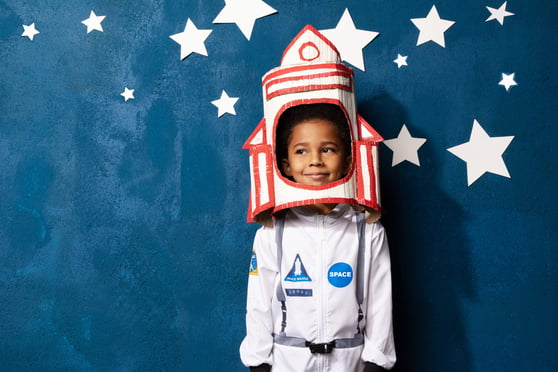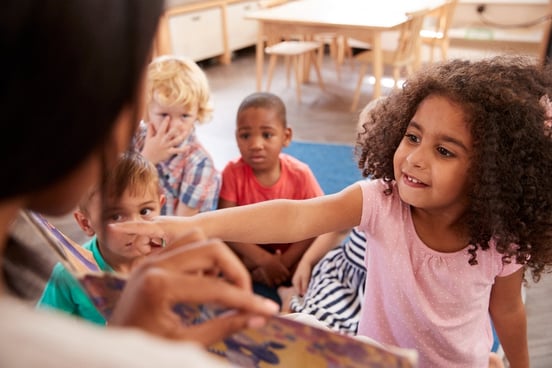STEMscopes Staff | Published May 10, 2023
Being a scientist and being told to think creatively automatically sound contradictory.
Science is about the facts, the data, and the experiments that prove a hypothesis that’s usually informed by something you already know.
But here’s the thing, among all those facts and unchangeable pieces of information, there’s some wiggle room for creative thinking. Even coming up with a hypothesis requires a little creativity.
Don’t all ‘guesses’ come from a creative place?
Within the STEAM learning lens, there’s room for creativity in this fact-based discipline.
Even if it’s something you already encourage of your budding scientists, there may be methods for bolstering creative thinking in science education that could come in quite handy.

Hopefully, we can all answer the question, what do scientists do?
They’re professionals who do things systematically. They research and gather evidence, sharing the knowledge they gain.
This general definition doesn’t reveal how scientists use creativity, but we know they can; otherwise, how would scientific discoveries occur?
The fact that we can conceptually combine science, technology, engineering, the arts, and mathematics into a single teaching strategy proves those “hard” sciences are not cut and dry.
Creativity is the secret component you may not hear a scientist talking about, but they use creative thinking daily when they play with ideas in their head or use trial and error to get to a solution.
Creativity even comes into play when a scientist decides how they’ll visually represent the data they’ve collected.
Even if they’re just using a graph or chart, there’s a bit of artistry involved in selecting colors and deciding which type of visual representation is most effective.
Seeing how creativity plays into science education is important because creative thinking is essential to learning.
Projects that require creative thinking engage students. They help them develop higher-level skills such as problem-solving and critical thinking.
Using creativity in the classroom also helps students connect between subjects; it allows you, as the teacher, to blur the lines, bringing relevant ideas from other classes into your science lab.
It also helps students connect new information to what they’ve already learned.
While understanding that creativity is essential— even in science— one of the best ways to instill creative thinking in your science students is through projects.
Getting students hands-on with science lets them learn the art of experimentation and allows them to practice some out-of-the-box thinking.
The most creative scientists are those who can take hard facts and turn them on their heads.
They can see something lurking in the data that nobody else has noticed, creating a unique hypothesis.
Encouraging students to think this way requires practice, and a project-based learning strategy is a great way to make this all come together organically.
This pairing works because project-based learning is more than just tossing in an activity here and there. It’s about infusing the entire curriculum with a project-based approach.
Crafting activities students work on over a more extended period of time so that they can put more thought into them is a tenant of project-based learning.
This lends itself readily to a science classroom and creative thinking.
Another significant piece of PBL that has considerable benefits in the science classroom is the learning strategy’s pliability to incorporate the real world.
Tying science to real-world examples in a hands-on environment helps students see how the concepts apply to them.
You can show students science in their own lives or their own community, then ask them to get creative in solving local issues or even strategizing ways to address potential problems.
You’re giving them the tools to think about the issue in a general way and the scenario where they need creativity to apply those tools.
With one easy prompt, you’ve incorporated all the tenants of PBL and gotten students to really think.
Examples of science activities that involve creative thinking are vast since creativity is applicable in every sect of science thanks to the hypothesis.
Whether they’re reimagining the big picture, focusing on a single component, deciding what direction to take, or making guesses, all of which require much creative thinking.
Not only must you imagine what the outcomes could be, but you have to create the method to get from your hypothesis to the solution.
From the hypothesis comes the application, a great place to really drive home the connection between science and original thought. To do this, the best type of project asks students to create something entirely new.
For example, ask students to create their own sundial after teaching them about the Earth’s rotation and the orbit of our moon and sun.
Then ask them:
Does your sundial give an accurate time when tested?Why did you pick these specific materials?
If the time wasn’t accurate, what adjustments did you make to address the issue?
Through an activity like this, students learn some science, are given complete freedom to apply it, and then have to explain why it worked/didn’t work and how they managed that.
This is the essence of scientific exploration.
Even when there’s no easy connection between a concept and creative thinking, there’s always a way to kick things up a notch.
How? The answer is art.
Creativity in the science classroom is easy to achieve if students are asked to display data.
They may only be working with hard facts and data points, but figuring out how to map that information so it’s easy to understand visually requires much thinking.
When we think about the science we know today, it’s easy to forget that at some point in history, what we know as facts were just creative ideas that still needed testing.
Thinking of Darwin, Einstein, Curie, Tesla (and so many others) — they brought new ideas into existence that have changed the world.
This is why creative thinking and science go hand-in-hand.
This is why teaching science shouldn’t be just about data and facts; it should be about how to use all that information to its greatest potential.
It’s about how those facts can inspire the next generation to think creatively like a scientist.

At the start of the school year, teachers have the chance to create a math classroom where every student feels valued...

Math manipulatives are a great way to make math more accessible for your students, especially if you know they may...

Storytelling is one of the oldest forms of communication as a way to share experiences, understand others, and...